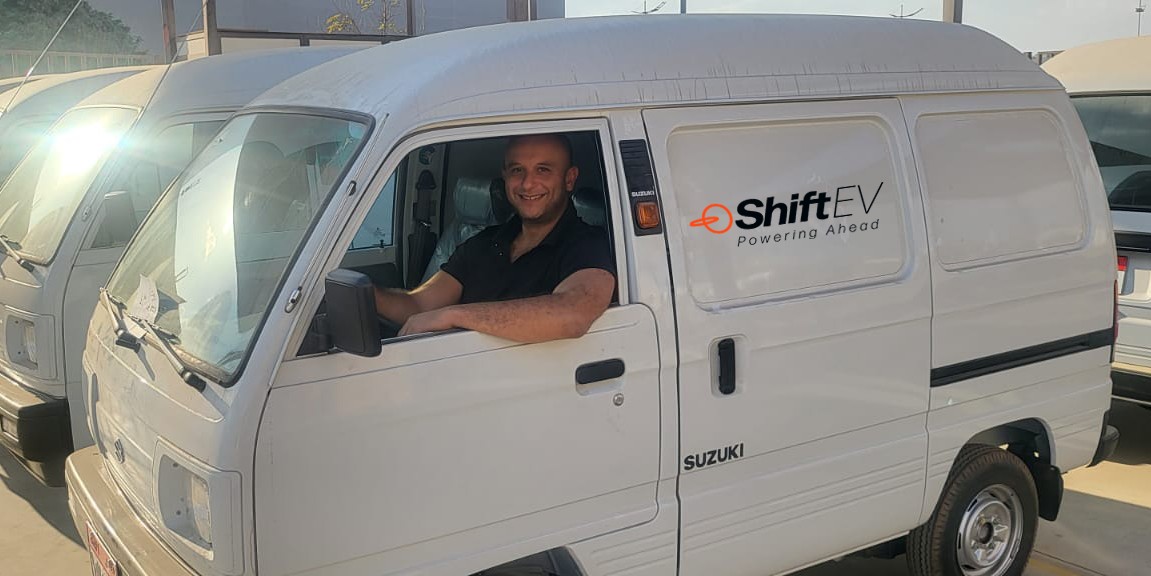Egypt’s Shift EV: Transforming the EV landscape in emerging markets

My name is Aly El Tayeb (LinkedIn) and I’m the CEO and co-founder of Egypt’s Shift EV.
After completing a dual degree at MIT I worked at US-based tech company Corning before joining grid scale storage battery startup Form Energy. I worked there for three years alongside a super star team that included the former vice president of energy at Tesla. There, I fell in love with building companies from scratch. Coupled with my deep interest in climate change, I partnered up with my co-founder Amr Helmy (Linkedin) to build Shift EV.
We built Shift EV to address the electric vehicle gap in Egypt and emerging markets.
What we do is convert delivery fleets into EVs in a matter of days — at no up-front cost. We developed a retrofitting process utilizing locally manufactured batteries that can turn any conventional vehicle into an EV.
It takes less than a few hours per vehicle to do the conversion. We take an assembly-line approach to convert fleets of minivans and tricycles and will soon do pickup trucks and microbuses— which are both essential to Egypt’s last-mile delivery and passenger fleets — into EVs. The conversion time goes down with every production cycle by 20-30%. I think we can easily get below an hour per vehicle. That goal is within reach.
Pushing down carbon emissions: When you switch from gasoline to electricity for a minivan, you offset 0.3 kilograms of CO2 per km. Our vehicles have traveled around 200k kms, and expect to cover between 750k-1 mn kilometers by the end of 2022. We also limit carbon emissions by retrofitting cars instead of manufacturing vehicles from scratch. Steel chassis produce emissions at an average of nearly 18 tonnes of carbon dioxide per vehicle. By retrofitting vehicles you give them a second life and extend their time on the road while eliminating emissions.
We raised a total of USD 9 mn during our series A funding round. The round was funded by Union Square Ventures, Algebra Ventures, Wamda, and the Oman Technology Fund.
We used the funds to scale our production and deploy more vehicles. In 4Q2022, we’re going into large scale serial production. For anyone who works in manufacturing automotives, they know that production ramp is when the magic really happens.
Future funding plans: We’re probably going to be raising again by the end of this year or the beginning of 2023 to expand our retrofitting rate to thousands of vehicles per year. Future funding will fuel our expansion plans and help us make inroads in other countries. We want to show that electric retrofitting doesn’t just work for one country or one chassis type.
Lobbying the gov’t and financial institutions: In the near term, we want to launch the retrofitting industry and turn it into an industry with full regulatory framework and end to end financing. We’re operationalizing with our financial partners a model similar to the power purchase agreement (PPA) model in renewable power, where customers pay off savings and not upfront. We’re currently doing this with our customers and partner financial institutions. We’re also focused on upping the amount of kilometers covered by the retrofitted vehicles we deploy. We worked with the Industry and Trade Ministry to develop a new industrial code for retrofitting technology because it’s separate from traditional automotive activity and we’ve been issued the first industrial register. The Interior Ministry also set up a new process to license electro-fitted vehicles which is a massive milestone for the industry and for us as a company.
Expansion plans: In the medium term, we will be focusing on scaling to deploy thousands of vehicles. We’re also planning on expanding into a couple of African countries. We think that’s a huge potential and relatively simple from a customer and manufacturing standpoint given the shared customer base and current trade treaties – most of our manufacturing is planned in Egypt. If we scale to the tens of thousands, I think we’re going to open the path accelerate the transition to electric mobility by decades.
Long term goals: As utilization of electric vehicles continues to grow, there’s going to be a need to start replacing batteries on existing vehicles. We want to make batteries a subscription for every single EV. Our long term strategy is to keep EVs on the road longer. EVs are often retired after 10 years of operation due to batteries’ loss of range. What we want to do is replace these faulty batteries to make it easy for the consumer to continue operating the vehicle with a very low cost.
To relax and switch off from work, I travel, build stuff, and connect with friends and family. You’d be surprised how little extra time one gets during the production ramp [laughs], but when I do have some time, I love to travel. I’m between the US and Cairo. I spend a lot of time in New York. Travelling enables me to see things in different ways and stay immersed in two cultures that I care deeply about.
I’m a huge nerd; the last great thing I read was Dune by Frank Herbert. I recognize that reading Dune at my age is a little bit too late, but I was blown away. I don’t think I have had a book in my hand that I couldn’t leave like Dune for a while. There are seven volumes. It gets weird towards the end. So, I wouldn’t recommend the last couple of volumes, but the first three volumes are so spot on and so interesting. I think I read them in like two or three days [laughs.]